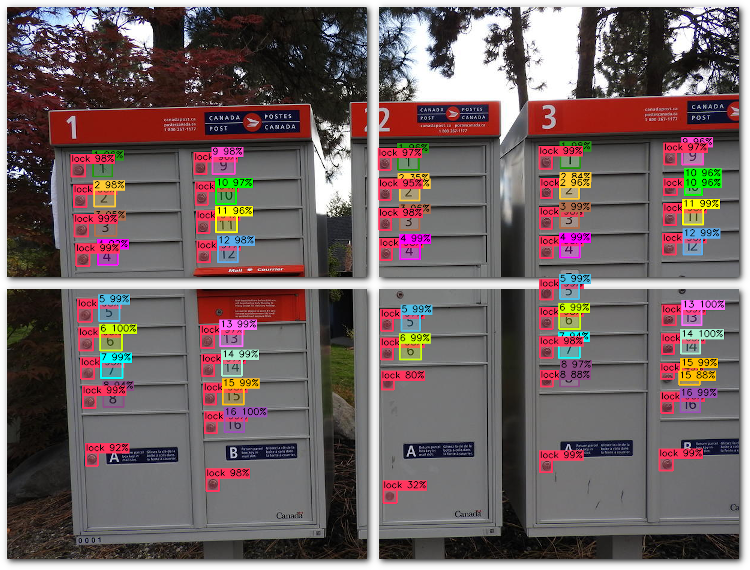DarkHelp is a C++ wrapper to make it easier to use the Darknet neural network framework within a C++ application. DarkHelp performs the following:
- load a Darknet-style neural network (.cfg, .names, .weights)
- run inference on images -- either filenames or OpenCV
cv::Matimages and video frames -- and return a vector of results - optionally annotate images/frames with the inference results
Example annotated image after calling DarkHelp::predict() and DarkHelp::annotate():
DarkHelp also has a very simple command-line tool that uses the DarkHelp API so some of the functionality can be accessed directly from the command-line. This can be useful to run tests or for shell scripting.
DarkHelp is open source and published using the MIT license. Meaning you can use it in your commercial application. See license.txt for details.
Extremely simple easy-to-follow tutorial on how to build Darknet, DarkHelp, and DarkMark.
DarkHelp requires that Darknet has already been built and installed, since DarkHelp is a wrapper for the C functionality available in libdarknet.so.
You must build Darknet with the LIBSO=1 variable set to have it build libdarknet.so. On Ubuntu:
sudo apt-get install build-essential git libopencv-dev
cd ~/src
git clone https://github.com/AlexeyAB/darknet.git
cd darknet
# edit Makefile to set LIBSO=1, and possibly other flags
make
sudo cp libdarknet.so /usr/local/lib/
sudo cp include/darknet.h /usr/local/include/
sudo ldconfig
Now that Darknet is built and installed, you can go ahead and build DarkHelp. On Ubuntu:
sudo apt-get install cmake build-essential libtclap-dev libmagic-dev libopencv-dev
cd ~/src
git clone https://github.com/stephanecharette/DarkHelp.git
cd DarkHelp
mkdir build
cd build
cmake -DCMAKE_BUILD_TYPE=Release ..
make
make package
sudo dpkg -i darkhelp*.deb
The Windows build uses vcpkg to install the necessary 3rd-party libraries such as OpenCV. See the files readme_windows.txt and build_windows.cmd for details.
Run the following commands to build Darknet and OpenCV:
cd c:\src
git clone https://github.com/microsoft/vcpkg
cd vcpkg
bootstrap-vcpkg.bat
vcpkg.exe integrate install
vcpkg.exe integrate powershell
vcpkg.exe install opencv[contrib,core,dnn,ffmpeg,jpeg,png,quirc,tiff,webp]:x64-windows darknet[opencv-base]:x64-windows
Once you finish building Darknet and OpenCV, run the following commands to build DarkHelp:
cd c:\src\vcpkg
vcpkg.exe install tclap:x64-windows
cd c:\src
git clone https://github.com/stephanecharette/DarkHelp.git
cd darkhelp
mkdir build
cd build
cmake -DCMAKE_BUILD_TYPE=Release -DCMAKE_TOOLCHAIN_FILE=C:/src/vcpkg/scripts/buildsystems/vcpkg.cmake ..
msbuild.exe /property:Platform=x64;Configuration=Release /target:Build -maxCpuCount -verbosity:normal -detailedSummary DarkHelp.sln
msbuild.exe /property:Platform=x64;Configuration=Release PACKAGE.vcxproj
Make sure you update the path to the toolchain file if you used a different directory.
DarkHelp has many optional settings that impact the output, especially DarkHelp::annotate().
To keep it simple this example code doesn't change any settings. It uses the default values as it runs inference on several images and saves the output:
// include DarkHelp.hpp and link against libdarkhelp.so, libdarknet.so, and OpenCV
//
const auto samples_images = {"dog.jpg", "cat.jpg", "horse.jpg"};
//
// Only do this once. You don't want to keep reloading the network inside
// the loop because loading the network is actually a long process that takes
// several seconds to run to finish.
DarkHelp darkhelp("animals.cfg", "animals_best.weights", "animals.names");
//
for (const auto & filename : samples_images)
{
// get the predictions; on a decent GPU this should take milliseconds,
// while on a CPU this might take a full second or more
const auto results = darkhelp.predict(filename);
//
// display the results on the console
// (meaning coordinates and confidence levels, not displaying the image)
std::cout << results << std::endl;
//
// annotate the image and save the results
cv::Mat output = darkhelp.annotate();
cv::imwrite("output_" + filename, output, {CV_IMWRITE_PNG_COMPRESSION, 9});
}
The official DarkHelp documentation and web site is at https://www.ccoderun.ca/darkhelp/.
Some links to specific useful pages:


